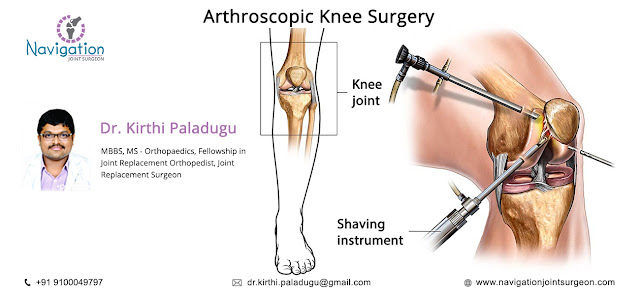Arthroscopic Knee Surgery in Hyderabad | Dr. Kirthi Paladugu
The Journal of Knee Arthroscopic Surgery
With technology spreading its
wings over the field of medical sciences, many advancements have taken the
flight of which the computer-assisted surgeries and the robotic surgeries are
prominent in the orthopedic domain. Another such surgery that falls under the
same cluster is the Arthroscopic surgery which has been gaining significance
over the past decade.
Arthroscopic or a Keyhole surgery
Arthroscopy which is also called
as arthroscopic or a keyhole surgery is a minimally invasive surgical procedure
on a joint in which an examination and sometimes treatment of damage is
performed using an arthroscope, an endoscope that is inserted into the joint
through a small incision.
The word arthroscopy comes from
two Greek words, "arthro" (joint) and "skopein" (to look).
The term arthroscopy literally means "to look within the
joint." In other words, arthroscopy is a surgical procedure that
orthopedic surgeons use to visualize, diagnose, and treat problems inside a
joint.
Knee Arthroscopy
Knee arthroscopy is that surgical
procedure which allows the doctors to view the knee joint making a small
incision (cut) through the skin and other soft tissues. The procedure is used
to diagnose and treat a wide range of knee problems.
How it works
In Knee arthroscopy, an orthopedic
surgeon makes a small incision in the patient's skin and then inserts the
pencil-sized instrument called arthroscope that contains a small lens and a
lighting system to magnify and illuminate the structures inside the joint.
Light is transmitted through fiber optics to the end of the arthroscope that is
inserted into the joint.
The arthroscope is attached to a
miniature television camera using which the surgeon is able to see the interior
of the joint through this very small incision, which is needed for a surgery.
The doctors view the joint through a small incision rather than a large
incision.
The television camera attached to
the arthroscope displays the image of the joint on a television screen or a
video monitor, allowing the surgeon to look throughout the knee in great
detail. The surgeon uses these images to see the cartilage, ligaments,
meniscus, and under the kneecap, determine the amount or type of injury and
then finally repair the injured knee, if required.
When is a Knee Arthroscopy recommended
Let us say, you have a painful
condition in your knee that is weighing you down completely and is not
responding to non-surgical treatment including rest, medications, physical
therapy, injections, etc that reduce the inflammation. It is then the doctors
recommend a knee arthroscopy.
Below are the common arthroscopic
procedures for the knee:
- Repair or removal of torn meniscus
- Removal of inflamed synovial tissue
- Removal of loose fragments of bone or cartilage
- Reconstruction of a torn anterior cruciate ligament
- Trimming of a damaged articular cartilage
- Treatment of patella (kneecap) problems
- Treatment of knee sepsis (infection)
Advantages of Knee Arthroscopy
- Very small incisions needed for open surgery
- Less pain for patients
- Less joint stiffness
- Relieves painful symptoms of many problems that damage the cartilage surfaces and other soft tissues surrounding the joint
- Shortens the time it takes to recover and return to favorite activities
Navigation Joint Surgeon:
Navigation Joint Surgeon uses
special instruments which are attached to the patients. Using the surgical
navigation system (camera), the location and the movement of the patient’s
knee/hip is tracked and navigated throughout the surgery. The system provides a
feedback of the instrument location which is particularly useful in situations
especially in minimally invasive surgeries where the surgeon cannot see the tip
of the instrument.
About Dr. Kirthi Paladugu:
Dr. Kirthi Paladugu is a Orthopedist, Joint Replacement Surgeon
and Sports Medicine Surgeon in Miyapur, Hyderabad and has a very good
experience in these fields. Dr. Kirthi Paladugu practices at Srikara Hospitals
in Miyapur, Hyderabad. He completed MBBS from Jagadguru Jayadeva Murugarajendra
Medical College (JJMMC) in 2009,MS – Orthopaedics from Raichur Institute of
Medical Sciences in 2013 and Fellowship in Joint Replacement from Germany in
2014.
Follow us on:
Google plus : https://plus.google.com/u/1/101088750512261777716
Facebook : https://www.facebook.com/NavigationJointReplacementSurgeon/
Twitter : https://twitter.com/SurgeonJoint
Contact us:
Dr.
KIRTHI PALADUGU
Consultant Orthopedic Surgeon,
Srikara Hospitals,#222 & 223,
Mythri Nagar, Phase-II,
Madinaguda, Miyapur, Hyderabad- 500 049.
Consultant Orthopedic Surgeon,
Srikara Hospitals,#222 & 223,
Mythri Nagar, Phase-II,
Madinaguda, Miyapur, Hyderabad- 500 049.

Comments
Post a Comment